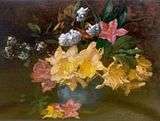Franz Deutmann

Franz Wilhelm Maria Deutmann (born 27 March 1867, Zwolle – died 18 July 1915, Blaricum) was a Dutch painter and photographer. He was a member of Arti et Amicitiae and is considered to be part of the Laren School, an offshoot of the Hague School,[1] which is an independent part of the international movement of impressionism.[2]
Biography

His father was Franz Wilhelm Heinrich Deutmann (1840–1906), a well known photographer. He studied painting with Jan Derk Huibers (1829–1919), a genre artist. After a brief stay in Germany in 1884, he enrolled at the Royal Academy of Fine Arts (Antwerp) from 1884 to 1887. During his studies at the academie he was a student of Prof. Charles Verlat.
In 1891, due to financial difficulties, he returned to Amsterdam and took a position in his father's photography studio.[3] By 1896, he had established himself as an artist and opened his own studio. Many of his works from this period have a sad feeling to them, and it is possible that he was suffering from depression.
In 1892 he moved to the artists' colony in Laren.[4] Plein air painting in the company of his fellow artists seems to have cheered him up. His portraits and figures were more colorful and lightly rendered, although his interiors still had a touch of melancholy. After a few years his depression returned again and he stayed in his studio, doing still lifes of flowers.[3][5]
His work was not as successful as most of his associates of the Laren School. After 1903, he went back to Amsterdam, but stayed there for only one year. Then he retired to Blaricum and lived in a house named "Heide-Weide" (Heide Meadows), which was later occupied by several other well-known artists and writers.[3] After a long illness he died at this place in the year 1915, aged only forty-eight.
Franz Deutmann has been a member of the Arti et Amicitiae and of the Kunstenaarsvereniging Sint Lucas.
His brother, Herman Deutmann, was also a photographer; well known for his portraits of the Royal Family.
In possession of the Museums of the Netherlands a.s.f.
- Historisch Museum, Amsterdam
- Rijksmuseum Amsterdam
- Stedelijk Museum, Amsterdam
- Groninger Museum, Groningen
- Gemeentemuseum, The Hague
- Singer Museum, Laren
Exhibitions
- 1903 Stedelijke internationale tentoonstelling van kunstwerken van levende meesters, Stedelijk Museum, Amsterdam.
- 1907 Stedelijke internationale tentoonstelling van kunstwerken van levende meesters, Stedelijk Museum, Amsterdam.
- 1912 Stedelijke internationale tentoonstelling van kunstwerken van levende meesters, Stedelijk Museum, Amsterdam.
- 1914 Tentoonstelling van werken door Franz Deutman: Laren, Rotterdam.
- 1916 Tentoonstelling van werken van Franz Deutman, Arti et Amicitiae, Amsterdam.
- 1917 Tentoonstelling. Atelier Franz Deutman, Amsterdam.
- 2005-2006 Groepstentoonstelling: Onstuitbare verzamelaar J.F.S. Esser : Mondriaan, Breitner, Sluijters e.a., Singer Museum, Laren
Gallery
 Franz Deutmann (1895): Knitting lesson - private collection.
Franz Deutmann (1895): Knitting lesson - private collection. Franz Deutmann (1914): Stil-life with flowers - private collection.
Franz Deutmann (1914): Stil-life with flowers - private collection. Franz Deutman (1913): Portrait of a young lady - private collection.
Franz Deutman (1913): Portrait of a young lady - private collection. Water tower of Zwolle.
Water tower of Zwolle. Zwolle: Thorbeckegracht oud.
Zwolle: Thorbeckegracht oud.
References
- ↑ The Hague School is at the end of the typical dutch development during the time of the Realism and Romanticism. The art historians do speak of the Dutch eye of the impression of the landscape, the people and the unique atmosphere.
- ↑ The independence begins with the choice of the themes, the colors and the dutch eyes of the interpretation.
- 1 2 3 Biographical notes @ De Valk Lexicon kunstenaars Laren-Blaricum
- ↑ From the perspective of the art historian he belonged to the 2nd generation of this school. His Œuvre can be assigned to the Hague School of the first generation.
- ↑ The rediscovery of still-life as subject belongs to the Amsterdam Impressionism.
Biographies
Catalogs
- Arti et Amicitiae, (1916): Catalog van werken van Franz Deutman, Publisher Arti et Amicitiae.
- Catalog Muller + Co. (1917): Atelier Franz Deutman, Amsterdam.
- Tentoonstelling van werken van Franz Deutman: Laren, (N.H.) Unger + Van Mens, Kunstzalen, 1914, Rotterdam.
Books
- Denninger-Schreuder, Carole (2003): Schilders van Laren, Thoth - Uitgeverij, ISBN 978-9-068-68327-1.
- Heyting, Lien (2004): De Wereld in Een Dorp, - schilders, schrijversen en wereldverbeteraaus in Laren en Blaricum, Medenhoff, ISBN 978-9-029-04856-9.
- Jonkman, Mayken; Raad, Jacqueline de (2005): Onstuitbare verzamelaar J.F.S. Esser: Mondriaan, Breitner, Sluijters e.a., Waanders, Zwolle, ISBN 978-90-400-9123-0.
- Koenraads, Jan P. (1985): Laren en zijn Schilders, Boekhandel Juli Kluvers, ISBN 978-9-071-16002-8.
Encyclopedia
- Scheen, Pieter A. (1981): Lexicon Nederlandse Beeldende Kunstenaars 1750-1950. 2 Volumes, 's-Gravenhage (The Hague), Kunsthandel Pieter A. Scheen N.V., p. 115.
External links
![]() Media related to Franz Deutmann at Wikimedia Commons
Media related to Franz Deutmann at Wikimedia Commons
- Posthumous appreciation from Elsevier’s Geïllustreerd Maandschrift, 1916, # 1